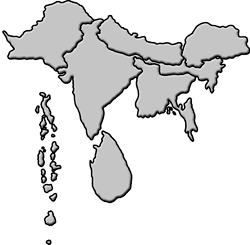 Then the Southasian Seven meet at the 13th SAARC summit in Dhaka on 6 February, they can take satisfaction in the small but significant achievements of their organisation. The very continuance of the South Asian Association for Regional Cooperation through the various India-Pakistan wars and war-of-words is a matter of some consequence. For creating a forum where ministers, prime ministers and presidents can meet with some regularity, we can thank the long-departed Ziaur Rahman, Rajiv Gandhi, JR Jayawardane, King Birendra and Zia Ul-Haq. And King Jigme and President Gayoom who are still with us.
Then the Southasian Seven meet at the 13th SAARC summit in Dhaka on 6 February, they can take satisfaction in the small but significant achievements of their organisation. The very continuance of the South Asian Association for Regional Cooperation through the various India-Pakistan wars and war-of-words is a matter of some consequence. For creating a forum where ministers, prime ministers and presidents can meet with some regularity, we can thank the long-departed Ziaur Rahman, Rajiv Gandhi, JR Jayawardane, King Birendra and Zia Ul-Haq. And King Jigme and President Gayoom who are still with us. The weaknesses of SAARC are of course many, for it started out as and remains, an external affairs project and secretariat. The directors are deputed from the foreign services of seven countries, their jobs are defined regardless of background and merit. The budget is infinitesimal. The plans tend to be grandiose, in inverse proportion to what is feasible. All seven foreign secretaries have to okay the Secretary General's every move and initiative. No wonder the SAARC Secretariat, fast by the Narayanhiti Royal Palace in Kathmandu, exudes such dreariness.
Beyond the institutional problems, however, there are conceptual issues that limit SAARC's utility other than serving as an annual talk shop and geopolitical safety valve. The state-centric construct of the organisation limits the interactions to the seven capital cities (towns, in the case of Male and Thimphu). As a result, even civil society's attempts at regional cooperation have tended to reflect capital concerns. One must learn to distinguish between 'SAARC' the organisation and 'Southasia' the region. For the moment, the former refers to its membership of seven nation states, while the latter speaks of more than 1.4 billion people, a fifth of Earth's population.
The greatest incongruity of SAARC is the manifest disproportion among its members. Whereas ASEAN or the European Union have countries of roughly comparable size and weight, Southern Asia presents a different picture altogether. In considering the limits of what SAARC can do as constituted or the way it must evolve, one may simply look at the variation in population size, land area, economic power and global reach of its largest and smallest members. (India: 1.1 billion population, land area of 3.2 million sq km. Maldives: 3.3 lakh population and atoll area of 298 sq km.)
Besides its gigantic presence, India is centrally placed and bordering on all the other Southasian countries, whereas none of the others touch each other. While the very distinctiveness of peninsular India gives all of Southasia its 'shape' in maps and satellite imagery, present-day India has even usurped the historical legacy of 'India' pre-1947.
Further, India already makes up much of Southasia in ways beyond population size or economic strength. Within India's expanse, you have everything from the Changthang high plateau to the Sundarban mangroves, Indian Ocean atolls to the Himalayan rimland, the Thar Desert to tropical rainforests. Given such an all encompassing presence of India in Southasia, there is no way for the state-centric SAARC not to be impacted at every turn by this behemoth.
India's overpowering situation is a reality confronting all its neighbours and this fact alone should help propel supplementary visions of Southasian regionalism other than SAARC's. While the regional organisation has us considering a Southasia of seven nation states and seven capitals, there are in fact other approaches with which to view this space. We can envision it as more than the seven countries, as a larger region with grey edges and encompassing Tibet, Burma and Afghanistan. We can consider regionalism as also encompassing bilateral relationships across adjacent nation state frontiers or we can conceptualise Southasia as constituting many sub-regions within each country.
Whereas today Southasian interactions are rigidly controlled by the capitals, regionalism with a focus on the people will blossom when adjoining regions of individual nation states are able to trade and travel with ease. Lahore must have access to Amritsar and Siliguri to Bogra. Southasian initiatives of the future will be the kind that promote links between Sindh and Gujarat/Rajasthan, Punjab state and Punjab province, Meghalaya and Sylhet. Those hung up on technicalities will term such initiatives 'bilateral' but it is the cumulative buildup of such linkages that will help complete the regional jigsaw that is Southasia. (Another time, I will try to defend my preference and proposal for the one-word spelling of 'Southasia'.)
Without doing violence to sacrosanct nation state sovereignty, it should also be possible to promote a version of regionalism that includes states, provinces and sub-regions as participant entities of a broadly-defined Southasia. In this sense, a truly federal India or Pakistan would be the best contributions to the goal of Southasian regionalism. Such would be the shape of Southasia of the future, which would require nothing less than rescuing our unitary past from the vivisection that has occurred. In the meantime, with hopes for the future, we will make do with an a-historical SAARC.



